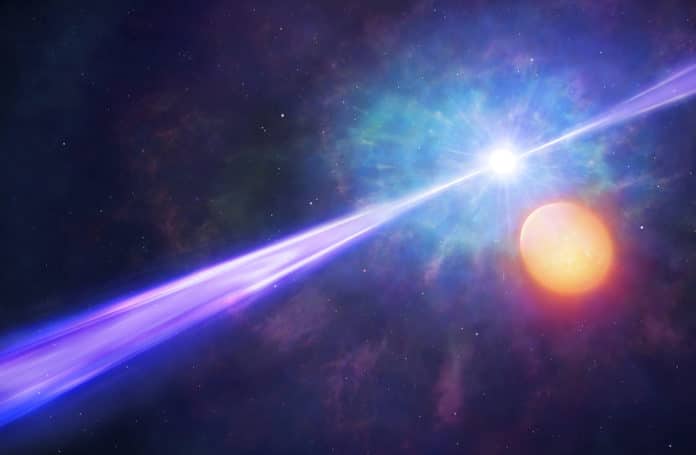How stars spin fast enough to create conditions to launch a jet of highly energetic material into space?
A new study that seeks to find out the answer to this question suggests that- when it comes to the biggest and brightest explosions, stars need a partner to make a gamma-ray burst.
Most of the stars are located in binary star systems. This study has shed light on the importance of such systems in creating massive explosions.
For this study, simulated models of thousands of binary star systems have been used by scientists.
They also examined a long gamma-ray burst (GRB) that occurs when a massive star about ten times the size of our sun goes supernova, collapses into a neutron star or black hole, and fires a relativistic jet of material into space. Rather than the star falling radially inwards, it flattens down into a disc to conserve angular momentum. As the material falls inwards, that angular momentum launches it as a fly along the polar axis.
But, to produce a jet of material, the star has to be spinning fast enough to launch material along the axis. This presents a problem since stars, for the most part, lose any turn they gain rapidly. By modeling the behavior of these huge stars as they collapse, the analysts have had the option to constrain the elements that cause a jet to be shaped.
Lead author Ashley Chrimes, a Ph.D. student at the University of Warwick Department of Physics, said: “We’re predicting what kind of stars or systems produce gamma-ray bursts, which are the biggest explosions in the Universe. Until now, it’s been unclear what kind of stars or binary systems you need to produce that result.”
“The question has been how a star starts spinning or maintains its spin over time. We found that the effect of a star’s tides on its partner is stopping them from slowing down, and, in some cases, it is spinning them up. They are stealing rotational energy from their companion, a consequence of which is that they then drift further away.”
“What we have determined is that the majority of stars are spinning fast precisely because they’re in a binary system.”
Dr. Elizabeth Stanway, from the University of Warwick Department of Physics, said: “Scientists haven’t modeled in detail for binary evolution in the past because it’s a very complex calculation to do. This work has considered a physical mechanism within those models that we haven’t examined before, which suggests that binaries can produce enough GRBs using this method to explain the number that we are observing.“
“There has also been a big dilemma over the metallicity of stars that produce gamma-ray bursts. As astronomers, we measure the composition of stars, and the dominant pathway for gamma-ray bursts requires very few iron atoms or other heavy elements in the stellar atmosphere. There’s been a puzzle over why we see a variety of compositions in the stars producing gamma-ray bursts, and this model explains.”
The study is published in the Monthly Notices of the Royal Astronomical Society.
